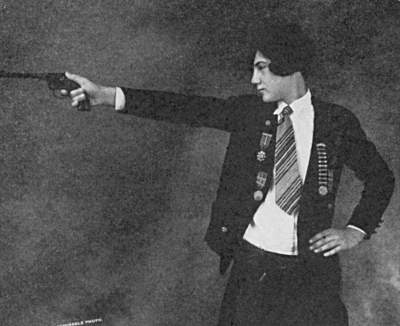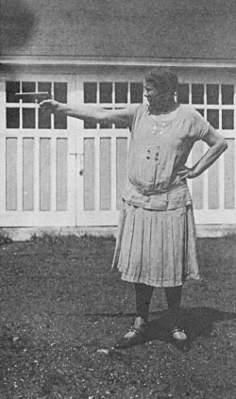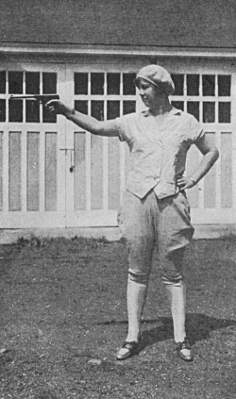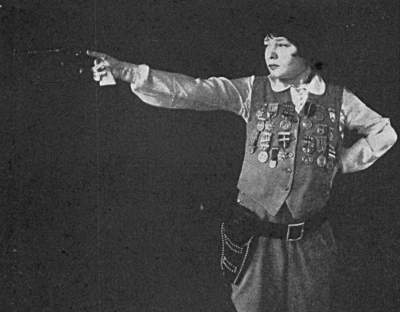The following information on the history of handgun shooting comes from Section 18 of Shooting by J. Henry FitzGerald. Shooting is also available to purchase in print.
A boy of ten years of age strolled into his father’s office and for want of something better to do proceeded to look over the big desk in the corner. After several compartments had been overhauled with neither gold or jewels as a reward, a pasteboard box was opened for inspection and inside it lay a beautiful ivory-handled, silver-plated, and engraved revolver, .22 caliber. Even at this age the youngster knew what it was for and how to shoot it (not hitting anything, of course). The box of cigars which was first thought of as a possible way to spend the rest of the day was pushed aside for the new find. What to do? First, to slip the treasure into the pocket (they put real pockets into the trousers of ten-year-old boys in those days), then another hunt for cartridges. Finally a box of. 22 caliber short cartridges was found and the shooting equipment was complete.
Looking as innocent as possible the youngster strolled out of the store to hunt up a tin can, which was not hard to find, and then to get about four miles away from any houses. The can was placed on a low stump at a distance of fifteen feet and the youngster was ready for business. After several minutes spent in inspecting the revolver it was pointed as accurately as possible at the can.
As the gun was fired another boy jumped out of the bushes at one side of the stump, and the bullet had gone through his big toe instead of the can. While no monument was erected, that shot created more trouble for a certain young man than the first shot in the Civil War. On arriving home the culprit was disarmed and sent to bed.

The next morning when he asked what had become of the revolver a large tub of water was pointed to as the resting place of his newly acquired friend. When no one was looking the youngster got the bright idea of getting possession of the revolver and as an old-fashioned auger lay in sight the use of this seemed the easiest way. So a hole was bored near the bottom of said tub, but the revolver was not found. If shooting a boy in the big toe caused a disturbance, boring a hole in that brand new tub caused a riot. Several months were spent in the search for the revolver, and after a while he found it. For the next few months all the boy’s spending money went for ammunition and then he told the owner of the gun how well he could shoot.
The demonstration that he gave of his shooting ability impressed no one, but he had learned to be careful and was allowed to keep the gun.
After months of labor the boy decided that the gun was at fault and he saved his pennies until enough wealth was accumulated to purchase a single shot pistol and then the fun began. He found that even with this pistol only a few holes could be found on the target a foot square with hand-painted bull’s-eye three inches in diameter shot at twenty yards. The youngster then conceived the idea of getting closer to the target and walked up to five yards; at this distance things began to happen and by close study of the pistol the bullet holes were nearly all in the bull’s-eye. Fifteen feet is a short distance, but it taught the youngster what he wanted to know and gradually increasing the distance one yard at a time, spending time enough at each range to eliminate wild shots, the fifteen-yard mark was reached. Several weeks were spent shooting at this range, all the time trying to extend the distance, but even one or two yards caused a decided drop in the scores. It was then decided that the pistol was too light, it was a Single Shot with six-inch barrel; so two heavier pistols with ten-inch barrels were purchased. From this time on all pistols or revolvers were bought in pairs and shot with right and left hand. With the new pistol and much perseverance twenty yards was reached and the scores ranged from sixty-five to seventy-five on the twenty-yard target.

For several years this pistol occupied every spare moment of the youngster’s time and then came the rifle age. All the popular rifles then on the market from 1891 to 1910 were tried in all calibers and finally discarded for the revolver and pistol. Even the bicycle then coming into popular favor only held the interest of the young man for a few seasons, and that only for the reason that the money won in races bought perfectly good revolvers and pistols.
Both rifles and bicycle were laid aside for the hand gun and about this time the young man became interested in police instruction. Several dashes of cold water were applied to this, because at this time the use of a revolver by police departments was not as necessary as it is today.
The real pleasure of shooting was not attained by the young man until quick draw and rapid-fire work was added to the regular target practice. Reloading was the next step and at one time fifteen reloading sets for different cartridges adorned the workbench.
Then, looking for more worlds to conquer, the arms were taken apart and the mechanism studied. As the young man was mechanically inclined he would take a part out of the pistol or revolver and make a part by hand to replace it. This was a very fascinating addition to the already overcrowded pastime and from this practice came the idea of correcting trigger pulls and other ailments to which a hand gun is susceptible.

For lack of contestants the young man would shoot with right and left hand. A pair of revolvers of each model were used for this purpose and marked right or left, all the scores being kept. A few medals and prizes were added to the collection, but it must be here stated that revolver and pistol matches were not so plentiful as they are today.
The work of adjusting trigger pulls and sights, and general repair work, due to the young man’s natural love for mechanics, will probably follow him to his grave. About 1897, in connection with a study of mechanism and inner workings of firearms, came, through an accident, the study of bullets fired from the same and different firearms. While on the range one day a bullet was picked up that had been fired from the .45 Single Action Colt revolver. The lines which showed plainly on the surface was enough to arouse the young man’s curiosity and after a hunt and much digging several other bullets were found. A microscope was purchased and the bullets examined and placed in two groups as having different markings. The pair of .45 Single Actions was then shot and the bullets caught in cotton waste and compared with the two lots previously found. The bullets matched perfectly and he could tell from any bullet found on the range which one of the revolvers it came from.
After this discovery many weeks and months were spent in the study of land and groove marks and also in the study of primer identification and shells. Thousands of experiments were performed, rifles, revolvers, and automatic pistols were shot, and bullets, shells, and primers compared. The effect of bullets on wood, glass, stone, metal, flesh and skin of animals, direction of bullets, powder stains, the distance at which black and smokeless powder will be discernable on an object, the effect of a contact shot, the comparisons of bullets of different manufacture, and many other valuable results were studied. This work was not easy for no books were obtainable and the study of this subject was practically unknown. Other microscopes were obtained and the subject was studied until it was an absolute fact that bullets, which retained a certain per cent of the land and groove marks or identification marks, could positively be identified as coming from a certain revolver or pistol if that arm could be found.
At least one hundred and fifty thousand experiments have been performed by this confirmed gun crank and years of experience in this work has made the comparison, which then took hours or days to complete, only a matter of minutes.
At this time in the story the man mentioned feels a great deal like the Frenchman who was carrying a bear back to camp. To quote his words: “I take those barr an’ start for camp; I start cross a stream on log; By Gar! ’bout halfway cross I think I fall, I hear a splash, I look ’round and it’s me.” And so the foregoing history tells you of my early shooting days.

From the old home I went to Boston and spent many pleasant years with the Iver-Johnson Sporting Goods Company in the revolver department. I was also shooting master of the Boston Rifle and Revolver Club. Twelve and one-half years after leaving Boston I again visited the club, and it was a pleasure to meet twenty-eight of the old members gathered again who had belonged to the club when I went away, and to see that the club was still going strong. As I mentioned in the club section, many lifelong friends are made on the shooting range and in my case this has proved to be true,—not only in Boston, but on the ranges all over the United States.
My love for the hand guns and their construction led me from Boston to the Colt’s Patent Fire Arms Manufacturing Company in Hartford, Connecticut, and in the testing room or shooting gallery of that company I spent nearly thirteen years. This work in connection with expert testimony, my connection as instructor with the police departments in the United States and Canada, and unlimited experiments with firearms have made these years pass like that many pleasant hours.
The ladies also enjoy target shooting, and some of my most enjoyable hours on the range have been spent with my wife and niece, who enjoy punching holes in the target as well as I do. The variety of arms which are favorites with them are all the models and calibers that I use, from .22 to .45 caliber, including the automatic pistols.
